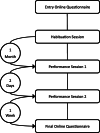Music performance anxiety from the challenge and threat perspective: psychophysiological and performance outcomes
- PMID: 32843074
- PMCID: PMC7448432
- DOI: 10.1186/s40359-020-00448-8
Music performance anxiety from the challenge and threat perspective: psychophysiological and performance outcomes
Abstract
Background: Although many musicians perceive music performance anxiety (MPA) as a significant problem, studies about the psychobiological and performance-related concomitants of MPA are limited. Using the biopsychosocial model of challenge and threat as theoretical framework, we aim to investigate whether musicians' changes in their psychobiological responses and performance quality from a private to a public performance are moderated by their general MPA level. According to the challenge and threat framework, individuals are in a threat state when the perceived demands of a performance situation outweigh the perceived resources, whereas they are in a challenge state when the perceived resources outweigh the perceived demands. The resources-demands differential (resources minus demands) and the cardiovascular challenge-threat index (sum of cardiac output and reverse scored total peripheral resistance) are the main indices of these states. We postulate that the relationship between general MPA level and performance quality is mediated by these challenge and threat measures.
Methods: We will test 100 university music students reporting general MPA levels ranging from low to high. They will perform privately (i.e., without audience) and publicly (i.e., with an audience) on two separate days in counterbalanced order. During each performance session, we will record their cardiovascular and respiratory activity and collect saliva samples and self-reported measures. Measures of primary interest are self-reported anxiety, the resources-demands differential, the cardiovascular challenge-threat index, sigh rate, total respiratory variability, partial pressure of end-tidal carbon dioxide and the salivary biomarkers cortisol, dehydroepiandrosterone, and alpha-amylase. Both, the participants and anonymous experts will evaluate the performance quality from audio recordings.
Discussion: The results of the planned project are expected to contribute to a more comprehensive understanding of the psychobiology of MPA and of the processes that influence musicians' individual reactions to performance situations. We also anticipate the findings of this project to have important implications for the development and implementation of theory-based interventions aimed at managing musicians' anxiety and improving performance quality. Thanks to the use of multimethod approaches incorporating psychobiology, it might be possible to better assess the progress and success of interventions and ultimately improve musicians' chance to have a successful professional career.
Trial registration: Not applicable.
Keywords: Biopsychosocial model; Cardiovascular activity; Challenge; Music performance anxiety; Music performance quality; Respiration; Salivary alpha-amylase; Salivary cortisol; Salivary dehydroepiandrosterone; Threat.
Conflict of interest statement
The authors declare that they have no competing interests.
Figures


References
-
- Kenny DT. The role of negative emotions in performance anxiety. In: Juslin PN, Sloboda J, editors. Handbook of music and emotion: theory, research, applications. Oxford: Oxford University Press; 2010. pp. 425–452.
-
- Fernholz I, Mumm JLM, Plag J, Noeres K, Rotter G, Willich SN, Schmidt A. Performance anxiety in professional musicians: a systematic review on prevalence, risk factors and clinical treatment effects. Psychol Med. 2019;49(14):2287–2306. - PubMed
-
- Craske MG, Craig KD. Musical performance anxiety: the three-systems model and self-efficacy theory. Behav Res Ther. 1984;22:267–280. - PubMed
-
- Aufegger L, Wasley D. Salivary cortisol and alpha-amylase are modulated by the time and context of musical performance. Int J Stress Manag. 2018;25(S1):81–93.
MeSH terms
Grants and funding
LinkOut - more resources
Full Text Sources

